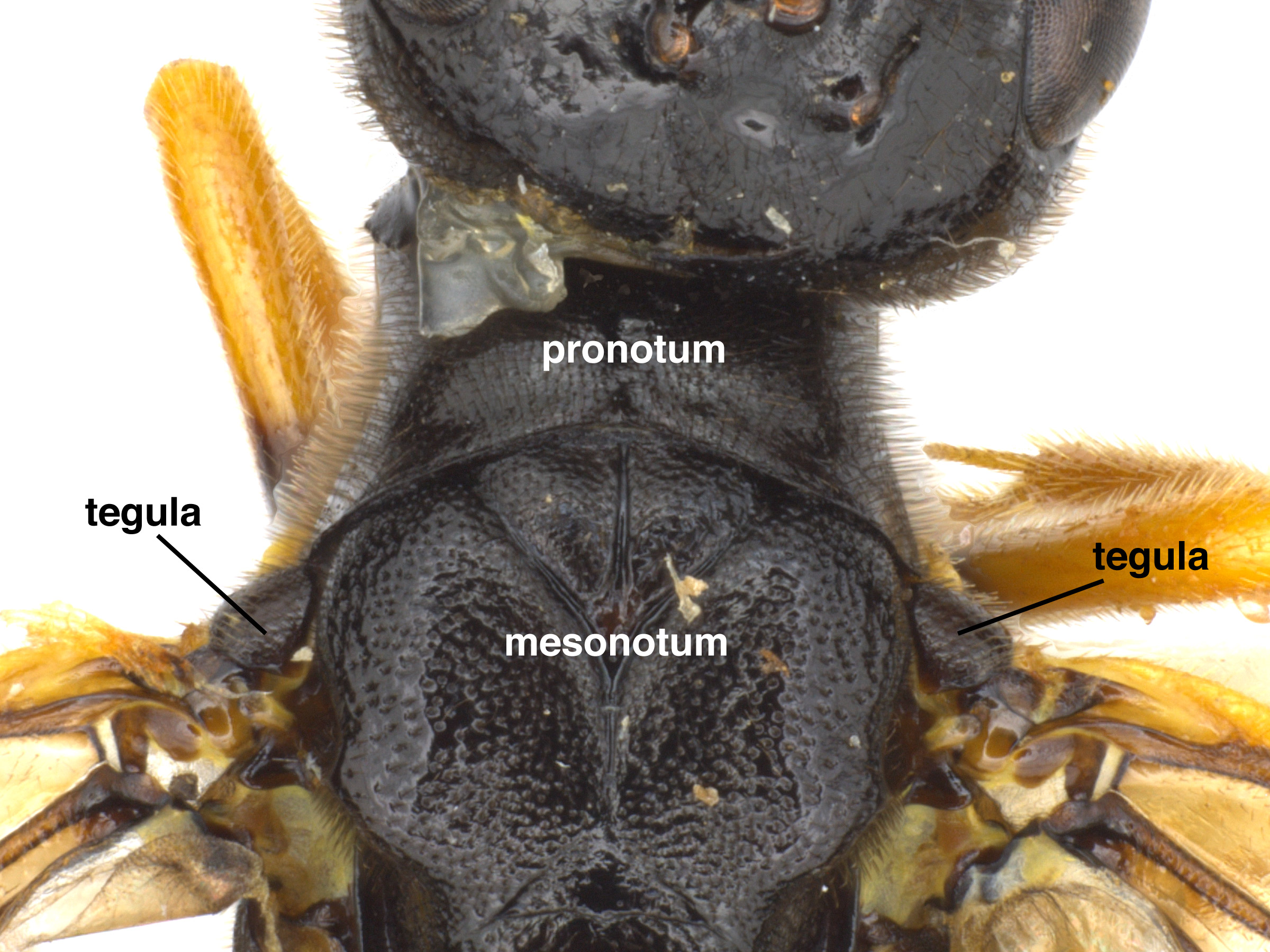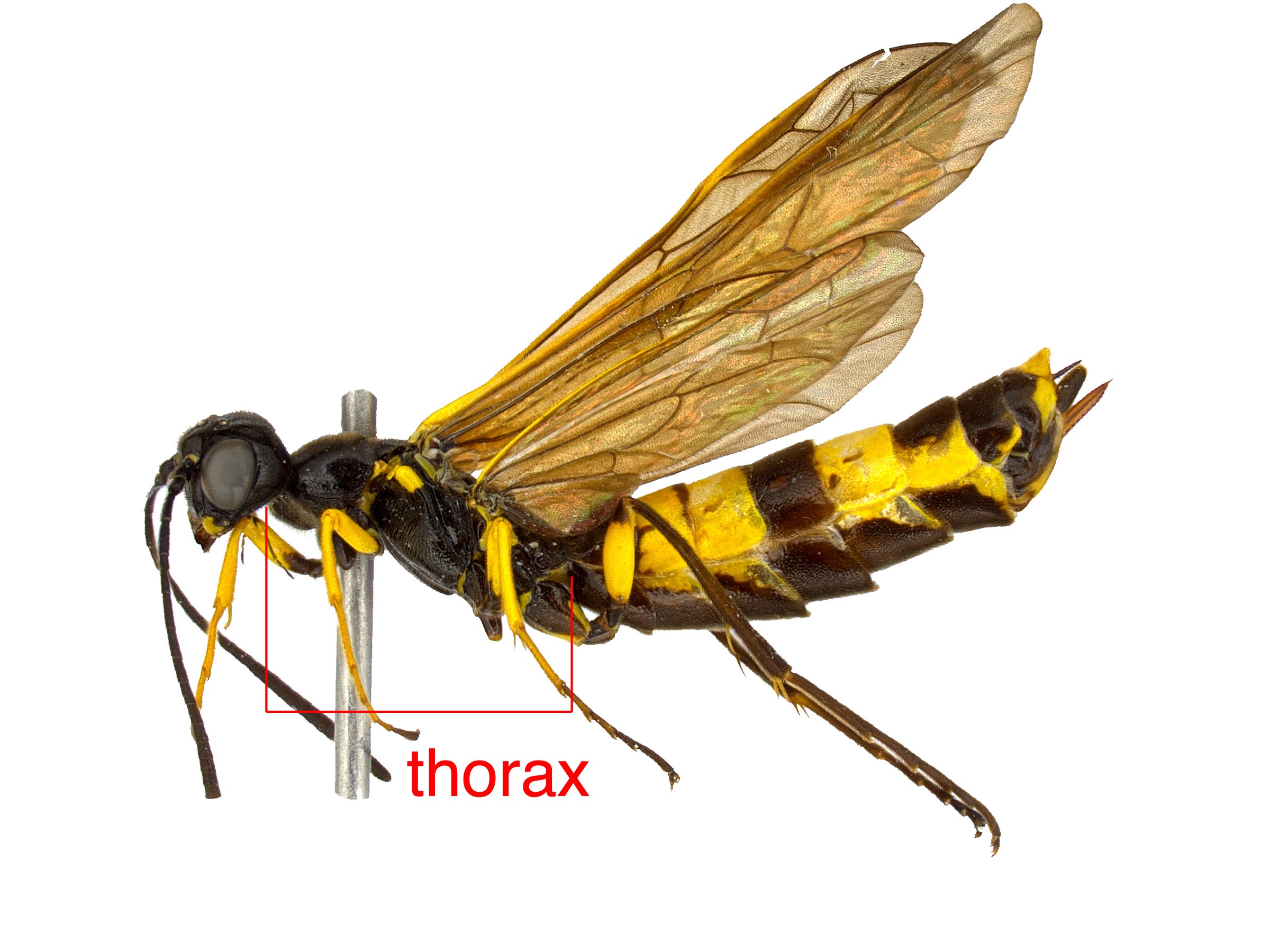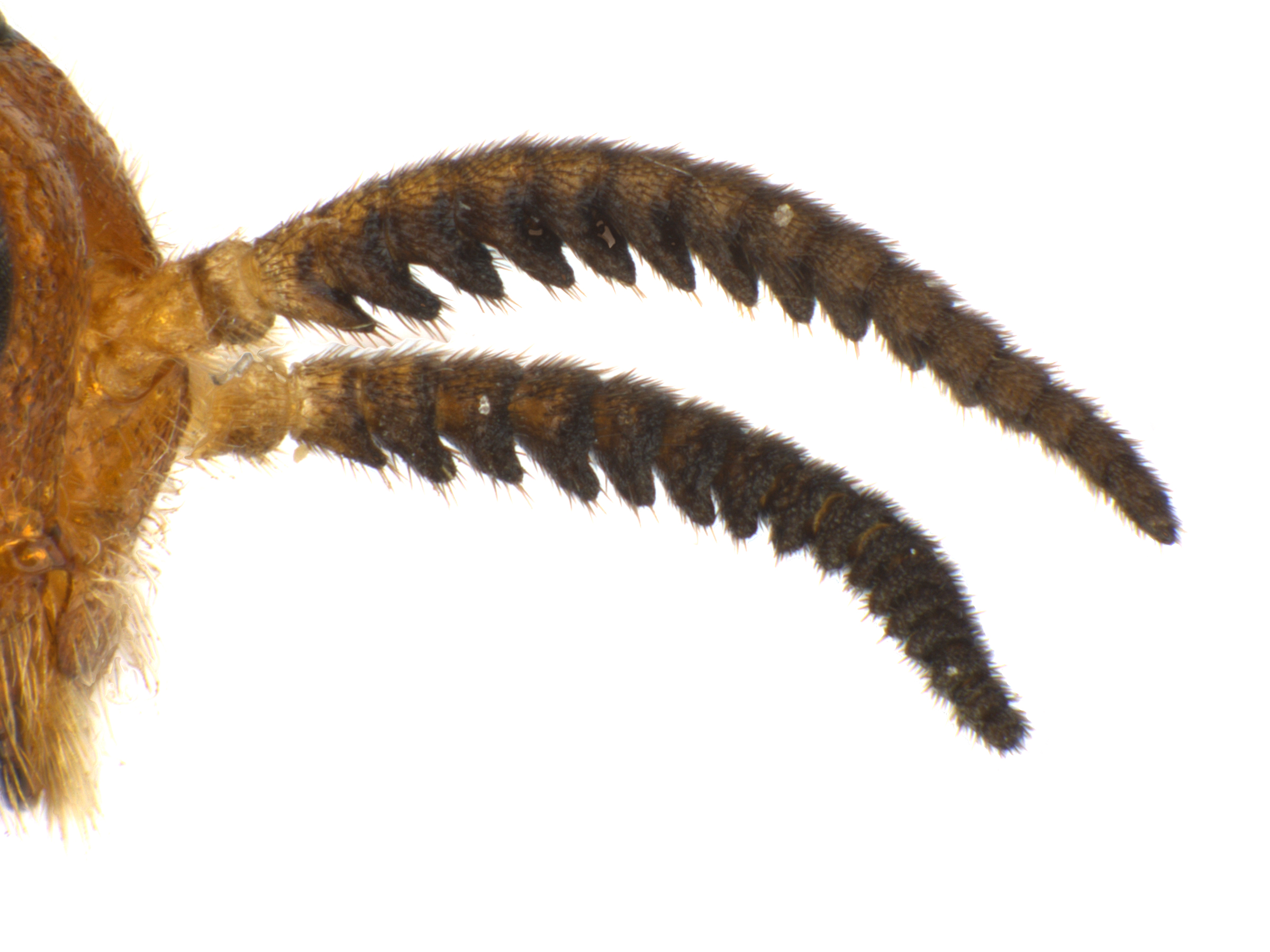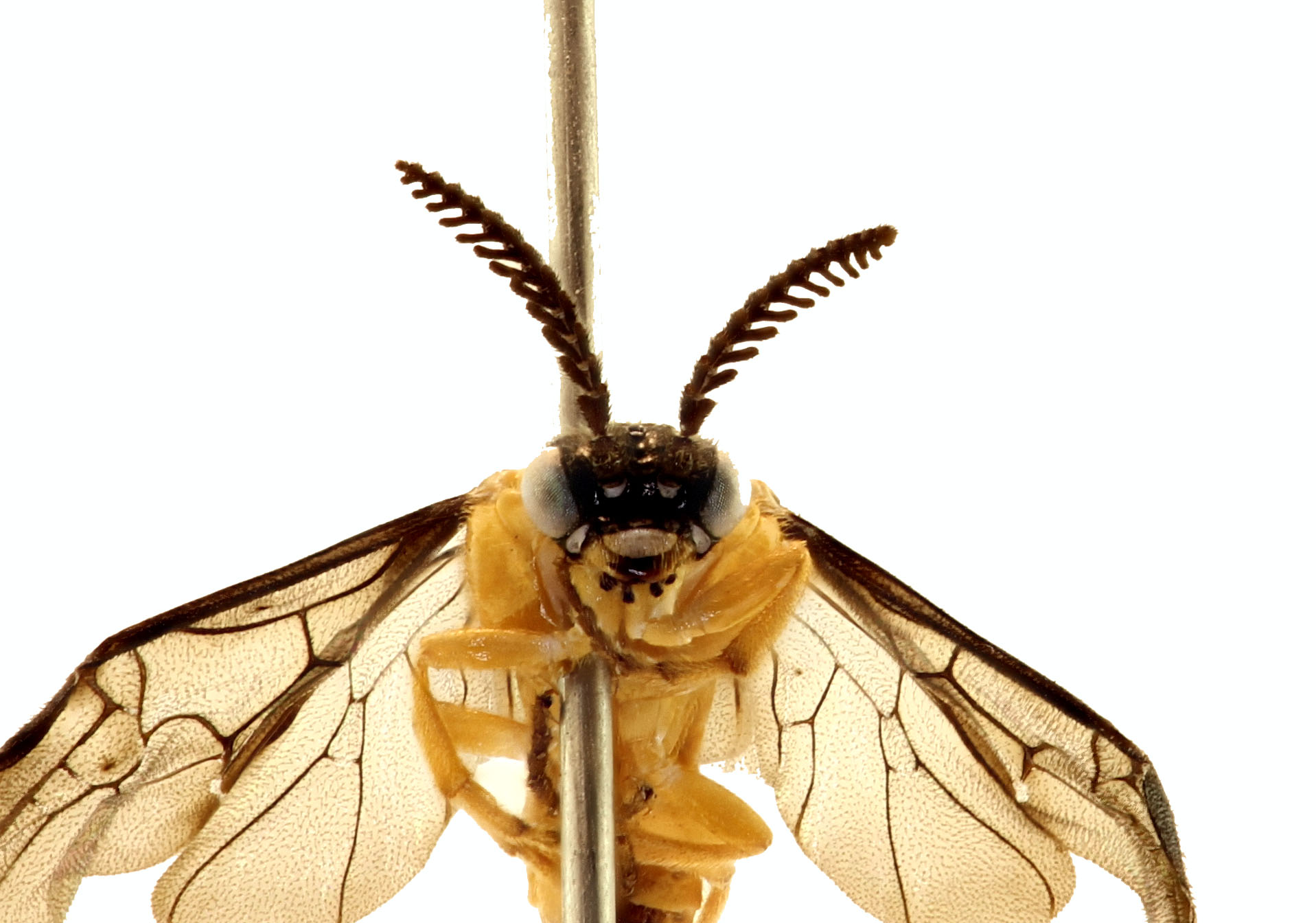Family: Diprionidae
Family common name: coniferconifer:
a usually evergreen tree characterized by reproductive cones; e.g., pine, fir, spruce, larch, etc.
sawflies
Subfamily: Monocteninae
Genus: Monoctenus Dahlbom, 1835
Subgenera: none
The Diprionidae are known as the coniferconifer:
a usually evergreen tree characterized by reproductive cones; e.g., pine, fir, spruce, larch, etc.
sawflies, though they are not the only family to use coniferconifer:
a usually evergreen tree characterized by reproductive cones; e.g., pine, fir, spruce, larch, etc.
trees as host (others include Siricidae, Pamphiliidae, Xyelidae, some genera of Tenthredinidae). Many are destructive pests as larvaelarva:
the immature stage of holometabolous insects
 , and so their biology has been more extensively studied than some other groups. Diprionids have stout bodies and distinctive antennal characteristics that make adults easy to recognize (Furniss and Carolin 1977Furniss and Carolin 1977:
, and so their biology has been more extensively studied than some other groups. Diprionids have stout bodies and distinctive antennal characteristics that make adults easy to recognize (Furniss and Carolin 1977Furniss and Carolin 1977:
Furniss RL and Carolin VM. 1977. Western forest insects. United States Deptartment of Agriculture Forest Service Miscellaneous Publication 1339: 1-655.).
Monoctenus is unique in the Diprionidae by using juniper trees as host. They are uncommonly observed, and, unlike closely related genera, seldom cause significant damage to their host (Rose et al. 2000Rose et al. 2000:
Rose AH, Lindquist OH, and Nystrom KL. 2000. Insects of eastern larch, cedar, and juniper. NRC mdash; Canadian Forest Service Forestry Technical Report 28.).
There are 13 described species worldwide, restricted to the Northern Hemisphere. Five species occur in North America (Taeger et al. 2010Taeger et al. 2010:
Taeger A, Blank SM, and Liston AD. 2010. World Catalog of Symphyta (Hymenoptera). Zootaxa 2580: 1-1064., Smith et al. 2010).
 strongly constricted medially, as seen from above (Goulet 1992Goulet 1992:
strongly constricted medially, as seen from above (Goulet 1992Goulet 1992: , no distinct “neck” (Goulet 1992Goulet 1992:
, no distinct “neck” (Goulet 1992Goulet 1992: in females, unipectinateunipectinate:
in females, unipectinateunipectinate: in males (Smith 1974bSmith 1974b:
in males (Smith 1974bSmith 1974b: 1A and 2A of fore wingfore wing:
1A and 2A of fore wingfore wing: fused in the center, making two distinct anal cells without a crossveincrossvein:
fused in the center, making two distinct anal cells without a crossveincrossvein: about truncatetruncate:
about truncatetruncate: vein M meeting Sc+R just basalbasal:
vein M meeting Sc+R just basalbasal: convex (Smith 1974bSmith 1974b:
convex (Smith 1974bSmith 1974b:Diprionidae are most easily recognized by the distinctive antennaeantenna:
the sensory organ emerging from the front of the head, usually between the compound eyes and above the clypeus; includes the flagellum, scape and pedicel
 of both sexes, but also are characterized by small, stout bodies. The subfamily Monocteninae can be separated from the Diprioninae (Diprion, Gilpinia, Neodiprion, Zadiprion) by the singular comb-like projection from each antennal segment, and by the fused veins 1A and 2A in the fore wingfore wing:
of both sexes, but also are characterized by small, stout bodies. The subfamily Monocteninae can be separated from the Diprioninae (Diprion, Gilpinia, Neodiprion, Zadiprion) by the singular comb-like projection from each antennal segment, and by the fused veins 1A and 2A in the fore wingfore wing:
the anterior wing of each pair of wings; usually the largest wing of the pair
 . It can be separated from Augomonoctenus by the truncatetruncate:
. It can be separated from Augomonoctenus by the truncatetruncate:
ending abruptly; cut off squarely; opposite of tapering
clypeusclypeus:
sclerotized area on the front of the head located between the antennal insertions and labrum
 and the fore wingfore wing:
and the fore wingfore wing:
the anterior wing of each pair of wings; usually the largest wing of the pair
 venation (Smith 1974bSmith 1974b:
venation (Smith 1974bSmith 1974b:
Smith DR. 1974b. Conifer sawflies, Diprionidae: Key to North American genera, checklist of world species, and a new species from Mexico (Hymenoptera). Proceedings of the Entomological Society of Washington 76: 409-418., Goulet 1992Goulet 1992:
Goulet H. 1992. The genera and subgenera of the sawflies of Canada and Alaska: Hymenoptera. Symphyta. The insects and arachnids of Canada. Part 20. Agriculture Canada Publication.).
none
Larvae in North America feed on trees of Cupressaceae. Most species feed on species of Juniperus (juniper), and a few also feed on Thuja occidentalis (eastern white cedar) and possibly other Thuja sp. (Smith 1974bSmith 1974b:
Smith DR. 1974b. Conifer sawflies, Diprionidae: Key to North American genera, checklist of world species, and a new species from Mexico (Hymenoptera). Proceedings of the Entomological Society of Washington 76: 409-418., Goulet 1992Goulet 1992:
Goulet H. 1992. The genera and subgenera of the sawflies of Canada and Alaska: Hymenoptera. Symphyta. The insects and arachnids of Canada. Part 20. Agriculture Canada Publication., Smith et al. 2010).
The biology of many species is unknown. Monoctenus fulvus females lay one egg at a time into the scale-like leaves of their host. After hatching, larvaelarva:
the immature stage of holometabolous insects
 feed on the foliage, usually at the new growing tips. LarvaeLarva:
feed on the foliage, usually at the new growing tips. LarvaeLarva:
the immature stage of holometabolous insects
 are longitudinally striped and measure about 30 mm at maturity. When disturbed, larvaelarva:
are longitudinally striped and measure about 30 mm at maturity. When disturbed, larvaelarva:
the immature stage of holometabolous insects
 will rear up the head and thoraxthorax:
will rear up the head and thoraxthorax:
the second and middle segment of the body, between the head and abdomen
 , similar to other Diprionidae. Mature larvaelarva:
, similar to other Diprionidae. Mature larvaelarva:
the immature stage of holometabolous insects
 will drop to the ground and burrow into the soil to overwinter and pupate. Monoctenus are univoltineunivoltine:
will drop to the ground and burrow into the soil to overwinter and pupate. Monoctenus are univoltineunivoltine:
describing an insect with a life cycle of one generation per year
(Marlatt 1886Marlatt 1886:
Marlatt CL. 1886. Notes on a red cedar saw-fly. Transactions of the Annual Meetings of the the Kansas Academy of Science 10: 80-83., Smith et al. 2010). Phenology is variable (Smith et al. 2010).
World: Species are recorded from North America, in Europe, and in Japan (Smith 1974, Taeger et al. 2010Taeger et al. 2010:
Taeger A, Blank SM, and Liston AD. 2010. World Catalog of Symphyta (Hymenoptera). Zootaxa 2580: 1-1064.).
North America: Monoctenus has two distinct ranges in North America. Three species occur in the east of Canada and the United States, from Quebec as far south as Virginia, west to Oklahoma; two species occur in central Mexico, one recorded in Durango, one recorded in San Luis Potosí (Smith 1974bSmith 1974b:
Smith DR. 1974b. Conifer sawflies, Diprionidae: Key to North American genera, checklist of world species, and a new species from Mexico (Hymenoptera). Proceedings of the Entomological Society of Washington 76: 409-418., Smith et al. 2010bSmith et al. 2010b:
Smith DR, Saacute;nchez-Martiacute;nez G, and Ordaz-Silva S. 2010. A new Monoctenus (Hymenoptera: Diprionidae) damaging Juniperus flaccida (Cupressaceae) in San Luis Potosiacute;, Mexico. Proceedings of the Entomological Society of Washington 112 (3): 443-450. https://doi.org/10.4289/0013-8797.112.3.444).
Map data from: GBIF.org (26 June 2019) GBIF Occurrence Download Monoctenus
Details about data used for maps can be found here.